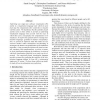Free Online Productivity Tools
i2Speak
i2Symbol
i2OCR
iTex2Img
iWeb2Print
iWeb2Shot
i2Type
iPdf2Split
iPdf2Merge
i2Bopomofo
i2Arabic
i2Style
i2Image
i2PDF
iLatex2Rtf
Sci2ools
VL
1995
IEEE
1995
IEEE
Toward Empirically-Based Software Visualization Languages
Underlying any single-user software visualization (SV) system is a visualization language onto which its users must map the computations they would like to visualize with the system. We hypothesize that the usability of such systems turns on their ability to provide an underlying visualization language that accords with the ways in which their users conceptualize the computations to be visualized. To explore the question of how to design visualization languages grounded in human conceptualization, we present an empirical study that made use of a research method called visualization storyboarding to investigate the human conceptualization of the bubblesort algorithm. Using an analytical framework based on entities, attributes, and transformations, we derive a semantic-level visualization language for bubblesort, in terms of which all visualizations observed in our study can be expressed. Our empirically-based visualization language provides a means for predicting the usability of the v...
Semantic-level Visualization Language | Single-user Software Visualization | Visual Languages | Visualization Language | VL 1995 |
| Added | 26 Aug 2010 |
| Updated | 26 Aug 2010 |
| Type | Conference |
| Year | 1995 |
| Where | VL |
| Authors | Sarah A. Douglas, Christopher D. Hundhausen, Donna McKeown |
Comments (0)

